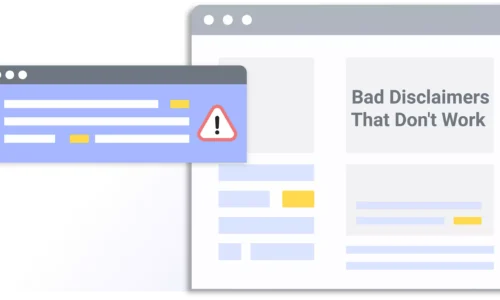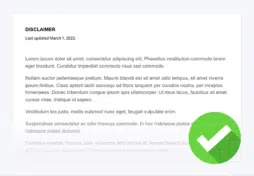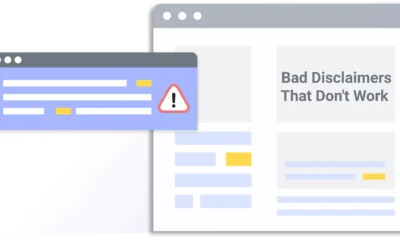Disclaimers can protect your business, but only if they’re done right.
Whether you’re trying to limit liability, clarify your responsibilities, or set expectations with your users, a poorly written or misplaced disclaimer can do more harm than good.
In this article, I break down the most common types of bad disclaimers, explain why they fail, and highlight the legal and reputational consequences of relying on them. If you’re relying on disclaimers to protect your business, this guide will help you ensure they’re effective.
Most Common Types of Bad Disclaimers
A poor disclaimer not only fails to protect you, but it can also damage your credibility with customers and regulators.
Too often, businesses rely on vague catch-all statements or copy-paste disclaimers they assume will cover them legally. In reality, not all disclaimers are lawfully enforceable, and some may increase your risk by creating a false sense of security.
Below are the types of disclaimers that often backfire, along with the reasons why they fail to hold up when it matters most.
The Catch-All, No Liability Ever Disclaimer
A disclaimer is supposed to set reasonable limits, but some businesses take it to the extreme with sweeping language that tries to shut down every possible claim.
You’ve probably seen versions like:
“We are not responsible for any damages, losses, or issues arising from your use of this website or our products.”
The problem with this approach is that it overreaches its bounds. No matter how broad the wording, a business can’t disclaim away every responsibility.
Courts, regulators, and customers all expect some level of accountability, and blanket disclaimers that deny it entirely often backfire.
Why these disclaimers don’t work
Here’s why this kind of sweeping language usually fails:
- They ignore consumer protection laws. Many rights, such as product safety and truthful advertising, can’t be waived.
- They’re rarely enforceable. Judges often strike down language that attempts to absolve a company of all liability as unconscionable.
- They undermine trust. Customers are less likely to feel secure when purchasing from a company that attempts to deny all responsibility.
- They can create complacency. Businesses relying on them may overlook other essential protections, such as contracts, insurance, or compliance practices.
In short, disclaimers that try to cover “everything” usually end up covering nothing.
Real-World Example
Amazon learned this lesson in Bolger v. Amazon.com, LLC (2020).
For years, Amazon’s agreements stressed that it was “just a platform” and not liable for the safety of products sold by third-party merchants.
When a defective laptop battery purchased through Amazon exploded and injured a consumer, Amazon cited this language as protection.
The California Court of Appeals disagreed. It ruled that Amazon’s deep involvement in the transaction, from warehousing to payment processing to shipping, made it a seller for purposes of product liability. The sweeping disclaimer that “Amazon isn’t responsible” didn’t stand up because it didn’t reflect reality.
The Buried Disclaimer
Some businesses attempt to protect themselves by hiding disclaimers in areas where customers are unlikely to notice them, typically in small font at the bottom of a page or concealed behind a lengthy block of text.
For a disclaimer to be effective, it must be clear and conspicuous. Courts and regulators expect disclosures to be visible and understandable to the average user.
Why buried disclaimers fail
These disclaimers fall short for several key reasons:
- They’re not reasonably visible. A user shouldn’t have to scroll endlessly or dig through dense legalese to find them.
- They conflict with the overall impression. If a site promises one thing but quietly contradicts it in the fine print, regulators consider that misleading.
- They erode trust. Users who do find them often feel tricked, which can damage credibility.
Real-World Example
In 2024, the Federal Trade Commission filed a complaint against USASDR, a debt relief company, for engaging in deceptive marketing practices.
On its website, USASDR prominently advertised “Debt Relief” services, but buried a small-print disclaimer at the very bottom of a long landing page stating it was not affiliated with the U.S. Department of Education and did not actually provide debt relief services.
The FTC concluded that this hidden disclaimer did nothing to correct the misleading impression created by the rest of the site. Instead, it highlighted that the company was attempting to evade responsibility while continuing to engage in deceptive practices.
The Ineffective Influencer Disclaimer
Influencers often think they’re covered by adding a hashtag like #ad or a line such as ” This is not financial advice.”
Still, when those disclaimers are vague, hidden, or inconsistent with the influencer’s actual behavior, they don’t offer much protection.
This is because there are specific FTC requirements influencers must follow when posting endorsements, sponsorships, and partnerships with other brands and companies.
Why these disclaimers fail
The most common problems with these influencer disclaimers include:
- They’re easy to miss. If the disclosure is buried after a “see more” cutoff, most followers won’t notice it.
- They use unclear language. Tags like #sp or #collab may not be obvious to all users.
- They contradict the content. Saying “this is not advice” while giving advice makes the disclaimer meaningless.
- They don’t meet legal requirements. Agencies like the FTC and SEC require clear and conspicuous disclosures; hashtags alone aren’t sufficient.
Real-World Example
In 2022, the SEC charged Kim Kardashian with unlawfully promoting a cryptocurrency token, EthereumMax (EMAX). Her Instagram post included both “#AD” and the phrase “this is not financial advice,” a common copy-paste disclaimer among influencers.
Despite that, the SEC found her in violation of securities law because she failed to disclose the $250,000 she was paid, as required by law. Kardashian ultimately paid $1.26 million to settle the case and agreed to refrain from promoting cryptocurrencies for three years.
The Contradictory Disclaimer
Some sites say one thing in disclaimers and the opposite in marketing or product descriptions.
For instance, a business might bury a line like “results are not guaranteed” while the rest of the site boldly promises guaranteed outcomes.
In these cases, the disclaimer not only fails but can also be used as evidence of deception.
Why contradictory disclaimers don’t work
This type of disclaimer backfires for a few important reasons:
- Mixed signals. Courts and regulators judge the overall impression, not the fine print.
- Deceptive look. It looks bad if your site’s main message contradicts the disclaimer.
- Damage trust. Customers feel tricked if the promises and disclaimers don’t match.
Real-World Example
In 2018, the FTC sued LendingClub for advertising loans with “No Hidden Fees” while still charging up-front origination fees that reduced the amount customers actually received.
Even though LendingClub disclosed the fees in fine print, regulators found that the bold headline promise was misleading, and the disclaimer didn’t cure the deception.
In 2021, LendingClub agreed to an $18 million settlement and was required to change its advertising practices.
The “We Can Change This Anytime” Disclaimer
Some businesses include language such as “We may update these terms at any time without notice” or “By using this site, you agree to any future changes.”
On the surface, it appears to be a way to stay flexible. In reality, these disclaimers often fail because they create one-sided agreements that courts consider unfair.
Why these disclaimers don’t work
Courts and regulators typically reject these disclaimers because:
- Unclear contracts. If one party can change the rules at will, there’s no real agreement.
- They don’t provide notice. Users can’t consent to terms they never saw or agreed to.
- They undermine trust. Users are less likely to feel secure if “rules” shift without warning.
Real-World Example
In the Zappos.com, Inc., Customer Data Security Breach Litigation (2012), Zappos’ Terms of Use included a clause stating, “We reserve the right to change this Site and these terms and conditions at any time, with or without notice.”
When customers attempted to bring claims after a data breach, Zappos cited its arbitration clause as a defense.
The court refused to enforce the clause, ruling that because Zappos gave itself unlimited power to change its terms at will, the entire agreement was illusory and unenforceable.
Why Bad Disclaimers Are Risky
A well-crafted disclaimer can set clear boundaries and protect your business, but when a disclaimer is poorly written or misplaced, it can actually increase your risk.
The biggest problem with bad disclaimers is the false sense of security they create. Business owners often assume that adding a blanket statement, such as “We are not responsible for…” is enough to cover them legally.
In reality, courts often dismiss vague or overly broad disclaimers as unenforceable.
There’s also the reputational risk to consider.
Customers notice when a disclaimer appears to be copied, contradictory, or deliberately hidden in fine print. Instead of reassuring users, a poorly worded disclaimer can convey the message that your business is careless or untrustworthy.
For disclaimers to be effective, they must be clear, tailored, and placed where users can reasonably expect to find them. Anything less can expose your business to legal disputes, regulatory scrutiny, and loss of customer trust.
What To Do Instead
A poorly worded disclaimer can expose your business to legal and reputational risk, but the solution isn’t complicated: you need disclaimers that are clear, tailored, and enforceable.
That means avoiding copy-paste language and using tools that guide you through the process step by step.
Instead of drafting from scratch, you can start with Termly’s resources.
The Disclaimer Template provides a framework for creating disclaimers that can help meet common needs, such as affiliate marketing, website use, or mobile app usage.
The Disclaimer Generator takes it a step further by asking about your business, industry, and use cases, then producing tailored disclaimers that you can publish immediately. It covers a wide range of business needs, including:
- Affiliate or advertising disclaimers
- Medical or fitness disclaimers
- Legal disclaimers
The generator also makes it easy to keep your disclaimers updated as your practices or regulations change, something a static copy-paste disclaimer will never do.
With Termly’s tools, you don’t have to rely on vague or outdated disclaimers that won’t hold up. Instead, you’ll get disclaimers designed to protect your business and build user trust.
Reviewed by Masha Komnenic CIPP/E, CIPM, CIPT, FIP Director of Global Privacy






